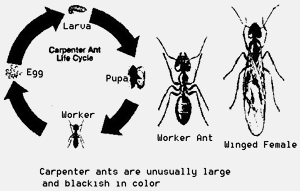

Carpenter ants are one pest that should be dealt with by a professional. Cain Pest Control has extensive skills and experience with these

ants assuring you full control in any type of structure. Even a mild infestation can quickly cause severe (and expensive) structural damage to any wooden structure.
Free Estimate
While damage from Carpenter ants and termites are very similar and are difficult to tell apart to the un-trained eye, there is a relatively easy way to distinguish between the two. Damage from carpenter ants will be free of mud and wood particles and the galleries will be smooth. If the damage to the wood is ragged with thin layers of wood packed with drying dirt, then termites are the most likely cause.
IDENTIFICATION AND LIFE CYCLE
There are many species of carpenter ants in Canada. Most of them have these common characteristics:
- Three part body. (head, thorax and abdomen)
- Colors: All black, dark brown, dark red, or a combination of these colors.
- Sizes: May have up to 5 different size ants in each nest. (10 to 20 mm.)
- Antenna has distinctive elbow.
- Observed under a magnifying glass, there is one "node" or spike between the thorax and the abdomen.
- Circular ring of hairs at tip of abdomen (gaster)
- No Stinger.
- Large mandibles for chewing tunnels in wood.
- Thorax has smooth rounded upper side.

Life Cycle and Habits

Carpenter Ants establish their initial nest in decayed wood, but, once established, the ants extend their tunneling into sound wood and can do considerable damage to a structure. They commonly nest in standing trees (living or dead), in stumps, or in logs on the forest floor. Since many houses are being built in forested areas, well established, vigorous colonies are readily available in the immediate vicinity to attack these dwellings. This is especially true when homes are built with a minimal removal of trees and stumps near the structure.
The parent nest is often located in a tree, stump, stacked wood within 100 meters of the house or wood and stumps buried in the yard when the house was constructed. Decorative wood landscape ties brought in to enhance the beauty of a yard or driveway may also be the location of a parent colony.
Satellite Nests
When the parent nest grows larger and needs room to expand satellite colonies are established. These satellite colonies often develop in nearby structures presumably because they offer warm protection. Only the parent nest contains the queen(s), young larvae and workers, while the satellite contains the mature larvae, pupae, workers, and/or winged reproductives.

Ants move back and forth from parent nest to satellite nest but just a few ( less than 10 % ) will be visible outside the nest. At times (usually late summer) workers can be seen moving mature larvae (white and grub-like) or pupae (papery cocoons) from one nest to another.
Food and Foraging
Ants are generally active along ant trails from April to mid-October. These trails follow natural contours and lines of least resistance and also frequently cut across lawns. Traffic on these trails may be noticeable during the day, but peak traffic occurs after sunset and continues throughout the night. The natural food for these ants consists of insects and other arthropods and sweet exudates from aphids and insects. They are also attracted to other sweet material such as decaying fruits.
Reproduction
The colony does not produce reproductives (winged males and queens) until it is from 3 to 6 years old and contains at least 2,000 workers. Reproductive carpenter ants ( winged males and females ) leave the nest as early as January if the nest is in a heated structure. Those living outside in logs and stumps will not swarm until about early May. The fertilized queens must then find wet wood to establish a new nest, and the cycle starts over again. The new queen could live 15 years or more and lay 70,000 fertilized eggs.
Carpenter Ant Control
Many pest management professionals consider carpenter ants the most difficult pest to control. This opinion is also expressed by many entomologists on government and university web sites. The only total control solution is to locate and eliminate all of the satellite nests in a structure, and if possible the parent nest which is usually outdoors. This requires considerable knowledge, skills and experience. Spraying pesticides on carpenter ants visible outside of the nests will have little or no effect on the rest of the colony. (Only a few workers ever leave the nests) It could result in the hidden nest splitting and moving. Common ant poisons available to consumers have no effect on carpenter ants. (They may work on some other ant species). Home remedies such as borax and sugar are likewise useless. The best solution is to phone us, request an estimate and consider the cost a worthwhile investment in the future value of your home.
Carpenter Ant Prevention
To prevent further carpenter ant infestations, trim all trees and bushes so branches do not touch the house. Eliminate other unnecessary vegetation touching the structure. Correct moisture problems such as leaky roofs, rain gutters and downspouts. Paint and/or seal exposed wood construction before it becomes wet. Replace previously ant- or termite-infested wood, rotted, or water-damaged wooden parts of the structure and eliminate wood/soil contacts. Remove dead stumps on the property and store firewood off the ground and away from the structure.
